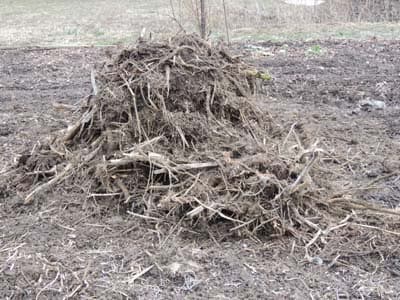Composting Techniques - The Compost Pile

About Compost Piles or Compost Heaps
The “compost pile”, or “compost heap” has been around for hundreds, if not thousands of years. Gardeners from ancient cultures piled weeds, branches, and other vegetation into a pile alongside their gardens. Over time, the material rotted away. Undoubtedly, these early gardeners tossed vegetables like pumpkins, squash, cucumbers, and tomatoes onto this pile, seeds and all. In the spring, some of the seeds sprouted. Then several weeks later, they observed that plants growing in this decayed pile were bigger and healthier than those they planted in the garden. It didn’t take much thinking to conclude that compost was indeed good for their plants.
These passive piles of vegetation aren’t pretty looking, and they sure are slow to decompose materials. But, they don’t cost anything either. And, it eventually does the job of converting vegetable matter into valuable compost loaded with valuable plant minerals and micro-nutrients. As a result, many gardeners use composting piles. A compost pile is a very simple, passive gardening technique. Simply designate a small area of your garden or yard, as a place where you will pile up compostable materials into a heap. Then, let Mother Nature and her friends perform the decomposition process over a long period of time.
Without a doubt, this method of composting requires the least amount of effort on your part, too. On the downside, materials take the longest time to decompose of any composting technique. The pile can also attract rodents and animal pests.
A passive compost heap can take six months to two years, for the materials to completely decompose. However, frequently turning the pile with a pitchfork will speed u the process.
How to Make a Compost Pile... It's a Cinch!
It doesn’t take much effort to establish a compost pile. Here is all you have to do:
- Designate an area for your compost heap.
- Then, add materials to the pile as they become available. When grass clippings are available, pile them on. When fall leaves are gathered, add them to the top of the pile.
- If you do nothing more than the two steps above, the materials will decompose over a lengthy period.
- However, to speed up the process, turn the pile over every once in a while.
- Finally, when decomposition is complete, take the material and use it in your garden projects.
- The material at the bottom and the center will finish first. If you need compost, dig out the finished compost, and rake the remainder back into a pile.
How to Speed Up Decomposition of a Compost Pile
- Alternate adding greens and browns.
- When starting a compost pile for the first time, mix in a couple of shovelfuls of garden soil. Or add some compost from the last pile. It contains millions of microorganisms that are essential to the decomposition process.
- Turn and mix the pile from time to time. These speeds up the process of decomposition.
- Keep the materials moist.
- Add earthworms or red worms to the pile.
- Compost Pile Tip: As you pile it on, your compost heap usually takes on the shape of an inverted “V”. Rainwater runs right off it and does not soak and penetrate through the compost materials. As you build the pile, form it into the shape of a volcano, with a crater at the top. This will help to collect rainwater, directing it to the center core of the pile.
Related Articles
Please support our site. Shop for:
- rmmatthews100@hotmail.com
- 585-721-6528
- Rochester, NY
©1999-2024 GardenersNet.Com, All Rights Reserved

